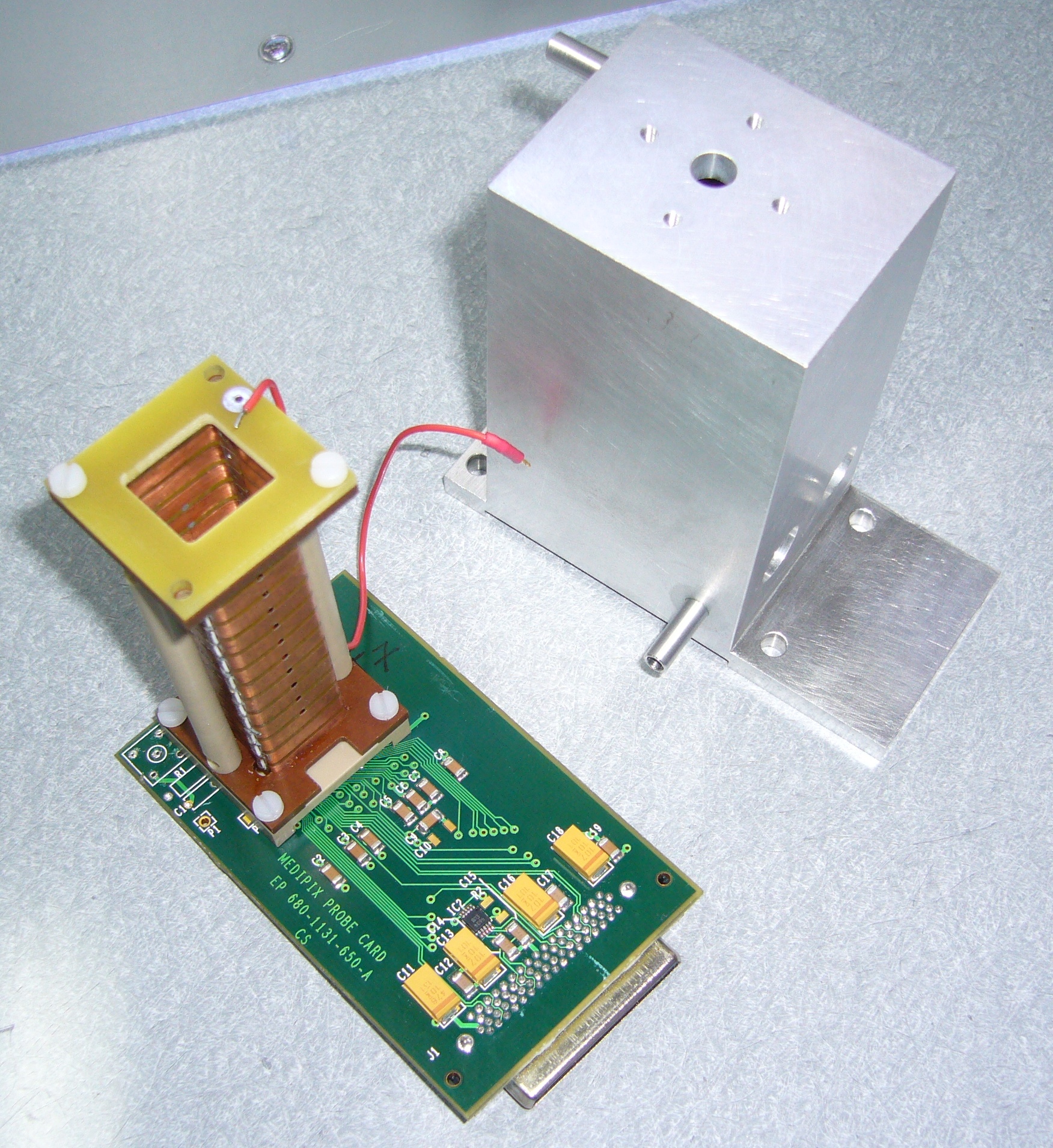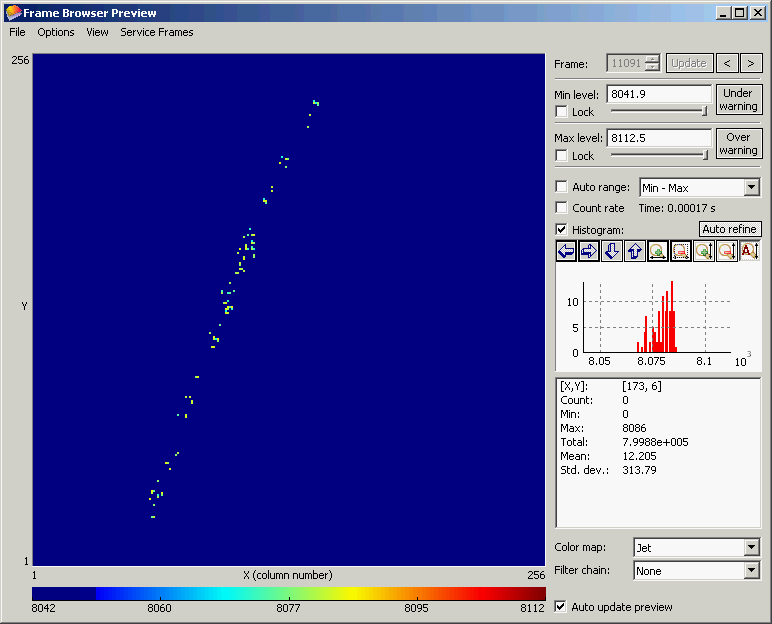A prototype of a novel charged particle detector has just been put to successful use by an IRFU-CERN-NIKHEF team working as part of the European EUDET project.
3D digital images of charged particle tracks have been obtained using the TimePix chip in conjunction with a Micromegas detector. This clears the way for building digital time projection chambers (TPCs) which could be used, for example, in building detectors for the future international linear collider (ILC). The novelty consisted in adding "clocks" to a more conventional chip to enable the arrival time of detection signals to be measured.
When a charged particle passes through matter, it strips off a few electrons along the way. Similarly, when an X ray encounters an atom, it takes an electron from it, which in turn goes on to extract other electrons until the energy of the initial X ray is depleted. This process is called ionisation, a phenomenon exploited by most particle detectors. In a gas detector, the charge must then be collected before the electron and ionised atom recombine. This is done using a moderate electric field. The charge is then amplified in an electric field that has sufficient intensity for each electron created to pick up enough energy to ionise another atom before it loses its energy as a result of elastic collisions. This leads to a sort of avalanche effect in which one electron yields two more, each of which yields another pair and so on. Ten such multiplications produce 1000 electrons, enough for a highly sensitive amplifier to detect.
The high-field region can be created in several ways. One way is to apply high voltage to a very thin wire. Another way is to stretch a grid some fifty micrometers above a flat conducting surface known as the anode. This is the method used in Micromegas detectors. In most Micromegas detectors, the anode is divided into pads or strips to add the effects of several tens of primary electrons and locate the point at which ionisation started.
The innovative feature just applied at the Saclay centre is the result of collaboration with Nikhef (the Dutch National Institute for Subatomic Physics) and CERN as part of Europe's EUDET project. The anode here is made using a chip with 65,000 digital pixels, each of which gives 0 or 1 according to whether or not it has received a detectable signal. The chip, known as TimePix, is an extension of Medipix2, a chip designed for biomedical X-ray imaging. Instead of defining "grey levels" by counting the number of photons detected by the silicon sensor on each pixel, a clock associated with each pixel measures the time between the arrival of the signal and the closure of a shutter at the end of a preset period of time. When an X-ray is converted in the gas, it produces a certain number of electrons by ionisation. An electric field causes the electrons to drift slowly towards the Micromegas detector (it takes them about 1 microsecond to travel the distance of 5 cm). When they reach the grid, they are multiplied by a gain factor of several thousand, making it possible to detect them with almost 100% efficiency. The result is a 3D image of the electron cloud produced by an X-ray in gas, one electron at a time.
In this type of detector, the ionising charged particles act just like an X-ray, stripping off electrons along their way. As these electrons drift towards the anode, they produce a 3D image of particle tracks where the third coordinate of each point is given by the drift time. This is the very principle behind a time projection chamber. It therefore seems feasible to use a digital TPC of this type to make a detector for the future linear collider. Besides the future TCP, there are many other applications in store for these novel detectors. First of all, they can be used to study the electronic properties of gases with unprecedented precision. The properties of a gas, such as electron drift speed, can be measured through a single X-ray conversion.
The direct search for dark matter entails detecting the ionisation produced when nuclei recoil on contact with a particle. These new detectors can do this with a major added advantage: directionality. As the detectors are precise enough to reconstruct the direction of recoil ions, it should be possible to reveal a clear signature of a halo of galactic dark matter. Because of the Earth's movement with respect to the galaxy, a dark matter wind that changes direction over a period of 24 hours should be observed.
Lastly, this type of detector can be used as a polarimeter for low-energy X-rays. When an X-ray collides with a gas atom, it strips off an electron from it. As a result, the electron cloud is generally rearranged leading to the emission of a second electron (known as an Auger electron). Both electrons are preferentially emitted in the polarisation direction of the initial X-ray. Polarisation can thus be measured by observing the direction of the emitted electrons.
Besides the future TCP, there are many other applications in store for these novel detectors. First of all, they can be used to study the electronic properties of gases with unprecedented precision. The properties of a gas, such as electron drift speed, can be measured through a single X-ray conversion.
The direct search for dark matter entails detecting the ionisation produced when nuclei recoil on contact with a particle. These new detectors can do this with a major added advantage: directionality. As the detectors are precise enough to reconstruct the direction of recoil ions, it should be possible to reveal a clear signature of a halo of galactic dark matter. Because of the Earth's movement with respect to the galaxy, a dark matter wind that changes direction over a period of 24 hours should be observed.
Lastly, this type of detector can be used as a polarimeter for low-energy X-rays. When an X-ray collides with a gas atom, it strips off an electron from it. As a result, the electron cloud is generally rearranged leading to the emission of a second electron (known as an Auger electron). Both electrons are preferentially emitted in the polarisation direction of the initial X-ray. Polarisation can thus be measured by observing the direction of the emitted electrons
Another particular feature of the TimePix chip is its ability to measure the period between the moment a signal rises above a threshold and the moment it drops below it, instead of measuring the time elapsed in relation to a fixed reference. The "time above the threshold" is directly related to the incident energy. This detector can therefore be used for spectroscopic purposes, offering spatial accuracy to within 55 µm. This could prove extremely useful in studying works of art, where the specific pigments in a tiny brush stroke could be detected.
These initial results were presented at the last IEEE conference in Dresden and work on applications for larger surfaces has only just begun. A larger, eight-chip detector is currently being made. Its performance should soon be observed in a test beam at DESY in Hamburg, again as part of the EUDET project.





